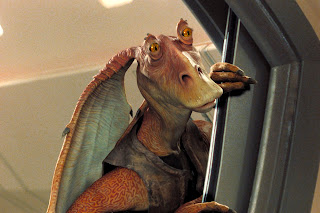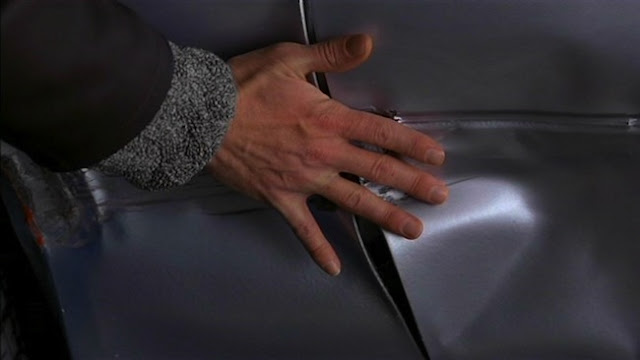Star Wars: The Phantom Menace (17 May 1999)
What if it had been good?
What if it had been a movie?
Star Wars Episode I: The Phantom Menace is the product placement of all time, the runestone, the grail, the altar upon which billions of dollars of cash will be placed in the next few weeks, and its surge of activity in the economy, coursing from fan-hand to Hasbro or Galoob bank, from T-shirt sweatshop to Lucasfilm coffers, may be more instrumental in lubricating the economy than any amount of e-commerce day-trading in Internet stock ever could. The Force is money. The movie is crap. That is, unless you're about 5 years old, and still enjoy hearing lines like, "Aw, Jar Jar Binks, you in deep doo-doo now!"
The bigs have weighed in—Rolling Stone, USA Today, the New York Daily News, Time, Newsweek, Variety, the Hollywood Reporter—mostly conceding that Star Wars Episode I: The Phantom Menace is platinum-hearted, product-pandering childsploitation of a low and monotonous order. (One hopes the small voices will pipe up against the dark side of the Force, as well.) One could criticize Star Wars Episode I: The Phantom Menace for the obvious that's there for all with eyes to see—that it's a feature-length animated cartoon with humans dropped in (for modest adult identification), poorly acted, lurchingly paced, and with dialogue on a level a notch or two above "Teletubbies."
But that misses the point. The movie doesn't matter. The jam-packed style of the film serves only to motor a merchandising blowout that has already outgrossed many small nations and most religions. But who needs to start a religion when you've got a billion-and-a-half dollars in merchandising revenue banked before a single ticket was sold? If we cannot find faith, we can at least download directions to the mall, and find Star Wars products to fill the emptiness in our lives and basements.
In a new biography of the late French film director François Truffaut, his once-friend and fellow director Jean-Luc Godard snipes at him with a put-down along the lines of, "Ah, François. Businessman in the morning, poet in the afternoon." On the evidence of Star Wars Episode I: The Phantom Menace, the one-time director of THX-1138 and American Graffiti no longer has poetry on his mind, only the merch: another cavil toward the notion that Lucas, the man, is a storytelling "genius."
In finding products to peddle, Lucas signs works the origins of which are more convoluted than the usual film production or the workshops of antiquity where painters would sign the work of their students. With immense resources at his disposal, Lucas can dragoon vast numbers of young and gifted talents to conceive of creatures, vistas and machinery that can then be absorbed into the Lucas corporate—sorry, story—structure as surely as Microsoft shovels up "intellectual property."
As with the appropriation of religious iconography, including the confounding suggestion that Annakin Skywalker is a parallel creature to Jesus Christ, this opportunistic mulching of style results in no style, only a very remunerative corporate compost that is little more than mush-mouthed New Age wishy-washiness. Instead of a sense of wonder, we're offered a sense of bewilderment.
What about the video game-style structure? Not only the obvious, the long, dodge-the-obstacles pod race across the desert, but the condescending, puzzle-piece pseudo-educational story structure that mimics Lucasarts video games with titles like "Monkey Island." A Jedi Knight's spaceship fails, so a part must be found. The junk dealer won't take Federation money, so a barter must be made. The barter introduces the Knight to Annakin, and another barter and a bet set up the pod race. Worse than the diagramming of a sentence, this structure follows the format of game "interactivity" to a dulling degree.
The casual racism is shocking as well. Samuel L. Jackson is shown as the only visible human in a Council meeting amid rubber puppets and computer-generated creatures. What's more exotic in the universe than a powerful black man? Or what about Watto, the junk dealer, a hook-nosed and vaguely Middle Eastern Shylock who owns the young Annakin? Or the fish-headed bad-guy ambassadors who speak in Charlie Chan cadences; or the film's central character, Jar Jar Binks, who speaks in motor-mouthed Jamaican-patois Stepin Fetchit "me no there go" voice. There's a line where a creature calls Annakin "a credit to [his] race"; with a glimmer of wit, the nasty line of yore would have been revised to "a credit to your species."
There's another racial element to Star Wars Episode I: The Phantom Menace: As our eyes scan the Big Daddy Roth-style rat finks that litter the crowd scenes, we have to wonder about the first Force-ful intergalactic ethnic cleansing: Where are the Ewoks, those gentle, fun-loving little characters. Banished to the back of the merchandising shelf?
What if it had been good? No chance.
That happened somewhere else, in some galaxy, far, far away.
[Appeared in a slightly different form in Newcity, 17 May 1999.]
What if it had been a movie?
Star Wars Episode I: The Phantom Menace is the product placement of all time, the runestone, the grail, the altar upon which billions of dollars of cash will be placed in the next few weeks, and its surge of activity in the economy, coursing from fan-hand to Hasbro or Galoob bank, from T-shirt sweatshop to Lucasfilm coffers, may be more instrumental in lubricating the economy than any amount of e-commerce day-trading in Internet stock ever could. The Force is money. The movie is crap. That is, unless you're about 5 years old, and still enjoy hearing lines like, "Aw, Jar Jar Binks, you in deep doo-doo now!"
The bigs have weighed in—Rolling Stone, USA Today, the New York Daily News, Time, Newsweek, Variety, the Hollywood Reporter—mostly conceding that Star Wars Episode I: The Phantom Menace is platinum-hearted, product-pandering childsploitation of a low and monotonous order. (One hopes the small voices will pipe up against the dark side of the Force, as well.) One could criticize Star Wars Episode I: The Phantom Menace for the obvious that's there for all with eyes to see—that it's a feature-length animated cartoon with humans dropped in (for modest adult identification), poorly acted, lurchingly paced, and with dialogue on a level a notch or two above "Teletubbies."
But that misses the point. The movie doesn't matter. The jam-packed style of the film serves only to motor a merchandising blowout that has already outgrossed many small nations and most religions. But who needs to start a religion when you've got a billion-and-a-half dollars in merchandising revenue banked before a single ticket was sold? If we cannot find faith, we can at least download directions to the mall, and find Star Wars products to fill the emptiness in our lives and basements.
In a new biography of the late French film director François Truffaut, his once-friend and fellow director Jean-Luc Godard snipes at him with a put-down along the lines of, "Ah, François. Businessman in the morning, poet in the afternoon." On the evidence of Star Wars Episode I: The Phantom Menace, the one-time director of THX-1138 and American Graffiti no longer has poetry on his mind, only the merch: another cavil toward the notion that Lucas, the man, is a storytelling "genius."
In finding products to peddle, Lucas signs works the origins of which are more convoluted than the usual film production or the workshops of antiquity where painters would sign the work of their students. With immense resources at his disposal, Lucas can dragoon vast numbers of young and gifted talents to conceive of creatures, vistas and machinery that can then be absorbed into the Lucas corporate—sorry, story—structure as surely as Microsoft shovels up "intellectual property."
As with the appropriation of religious iconography, including the confounding suggestion that Annakin Skywalker is a parallel creature to Jesus Christ, this opportunistic mulching of style results in no style, only a very remunerative corporate compost that is little more than mush-mouthed New Age wishy-washiness. Instead of a sense of wonder, we're offered a sense of bewilderment.
What about the video game-style structure? Not only the obvious, the long, dodge-the-obstacles pod race across the desert, but the condescending, puzzle-piece pseudo-educational story structure that mimics Lucasarts video games with titles like "Monkey Island." A Jedi Knight's spaceship fails, so a part must be found. The junk dealer won't take Federation money, so a barter must be made. The barter introduces the Knight to Annakin, and another barter and a bet set up the pod race. Worse than the diagramming of a sentence, this structure follows the format of game "interactivity" to a dulling degree.
The casual racism is shocking as well. Samuel L. Jackson is shown as the only visible human in a Council meeting amid rubber puppets and computer-generated creatures. What's more exotic in the universe than a powerful black man? Or what about Watto, the junk dealer, a hook-nosed and vaguely Middle Eastern Shylock who owns the young Annakin? Or the fish-headed bad-guy ambassadors who speak in Charlie Chan cadences; or the film's central character, Jar Jar Binks, who speaks in motor-mouthed Jamaican-patois Stepin Fetchit "me no there go" voice. There's a line where a creature calls Annakin "a credit to [his] race"; with a glimmer of wit, the nasty line of yore would have been revised to "a credit to your species."
There's another racial element to Star Wars Episode I: The Phantom Menace: As our eyes scan the Big Daddy Roth-style rat finks that litter the crowd scenes, we have to wonder about the first Force-ful intergalactic ethnic cleansing: Where are the Ewoks, those gentle, fun-loving little characters. Banished to the back of the merchandising shelf?
What if it had been good? No chance.
That happened somewhere else, in some galaxy, far, far away.
[Appeared in a slightly different form in Newcity, 17 May 1999.]


